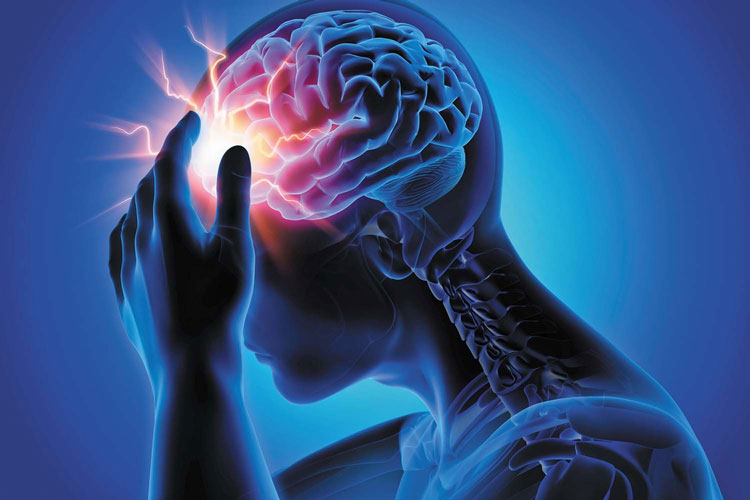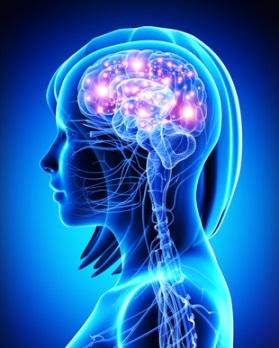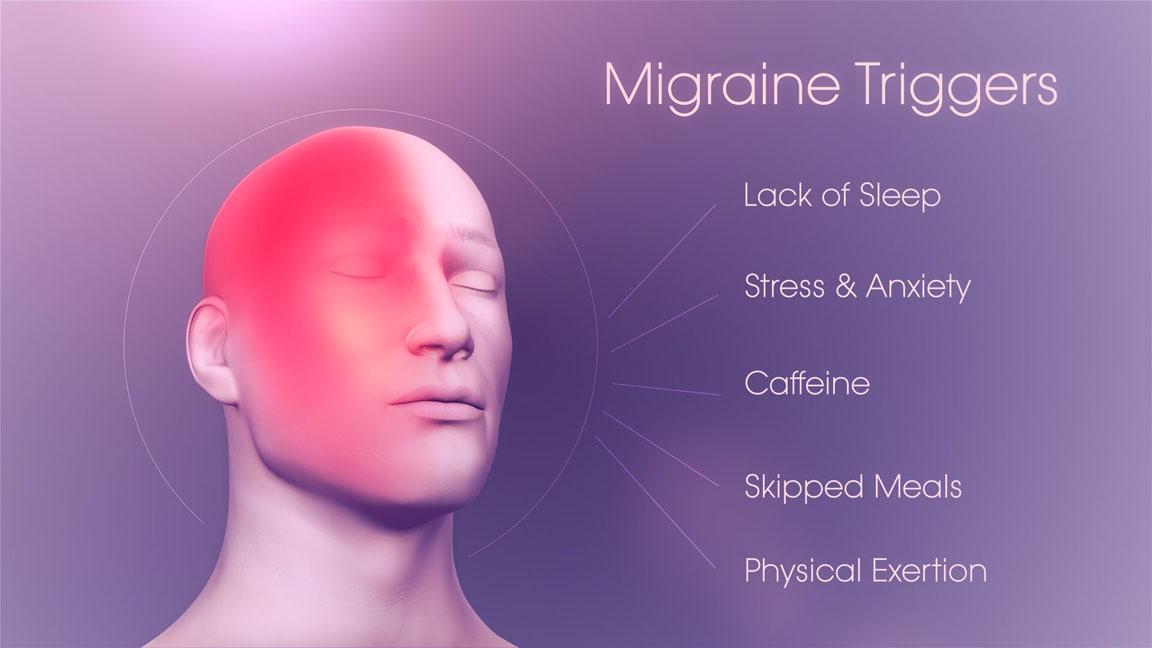Migraine is a neurological disease, which involves pulsating sensation or severe throbbing pain. It is usually on one side of the head. Migraine episodes can last from hours to days and it might affect the daily activities of people.
There are about 150 types of headache which are divided in 2 categories: primary and secondary headaches. Primary headache is not caused by any medical condition and secondary headache is a symptom of some medical condition. Migraine is a primary headache.
Migraine is most common among people of ages 18 to 44. Women are more susceptible to getting migraine attacks than men. Many women find that their migraine gets better after the age of 50. It has also been researched that migraine runs in the family.
If one parent has a history of migraine; 50% chances are that the child will have it too. In case both parents have migraine headaches the chances of the child having it is about 75%.

CAUSE OF MIGRAINE
The exact cause of migraine is not known yet. It is a neurological disease which is related to the way nerves communicate, balance of chemicals in the brain, effect on blood vessels and your genes.
As per the researchers, migraine starts when the overactive nerve cells send out signals that trigger your trigeminal nerve. This gives sensation to your head and face. This signals the body to release chemicals like serotonin and calcitonin gene-related peptide (CGRP) which makes blood vessels in the lining of the brain swell. Neurotransmitters released cause inflammation and pain.
Types of ADHD
Migraine can be triggers from multiple factors like:
- Hormonal changes – women experience migraine episodes around the time of menstruation cycle, during pregnancy or while ovulating.
- Emotional turmoil – Anxiety, depression, stress and exhilaration can trigger the episode.
- Medication – Some medicines like sleeping pills, some birth control pills or hormone replacement therapy (HRT).
- Dietary factors – Some food like alcohol, caffeine, chocolate, cheese, citrus fruits, or foods containing tyramine, monosodium glutamate, aspartame etc. Skipping meals or inadequate amounts of food or water can also trigger migraine episodes.
- Environmental factors – Loud noises, dim or inappropriate lighting, temperature variation, strong smell, weather changes (strong winds or scorching heat) or flickering screen .
- Physical factors – Lack of sleep, poor posture, tiredness, and shoulder & neck tension.
SYMPTOMS OF MIGRAINE
Symptoms of migraine may occur in 4 stages. Not everyone might experience all these stages.
Prodrome – This is the beginning of the migraine episode where you may experience sensitivity to light, sound, or smell; fatigue; food cravings or lack of appetite; mood swings from depression to euphoria; increase in thirst or urination; frequent yawning; stiffness of neck; bloating or constipation or diarrhea. This might begin 1 or 2 days prior to migraine and warn you about the headache.
Aura – These are sensory, motor and speech symptoms that might occur before or during the migraine attack. The start gradually, build-up over several minutes and might last for about 5-20 minutes. You might experience:
Disturbance in vision like seeing black dots, wavy lines, flashes of light or various shapes.
- Loss of vision or tunnel vision
- Tingling or numbness in arms or legs
- Difficulty in speaking
- Changes in smell, taste or touch
- Tinnitus like feeling in ears
- Difficulty in speaking clearly

Attack – This starts with a dull headache and gradually grows into throbbing pain. The pain is usually on one side of your head which might move to the other side or in front of your head. Many people have nausea, pale, clammy or feel faint along with headache and about half might get vomiting. Vomiting usually relieves the headache.
Attack may last about 4 hours and in severe cases it may even last for more than 3 days. The frequency ranges from 2-4 headaches per month to 1-2 headaches per year. If the attack occurs for about 15 per month it is a chronic migraine.
Postdrome – This lasts for a day after the attack. You might feel tired, wiped out, or cranky; muscle pain or weakness; lack of appetite or craving for certain food. Sudden head movement might cause the pain to start again.
The migraine episode could be without head pain which is known as silent migraine or acephalgic migraine. People would experience aura symptoms but not the headache.
Sometimes the symptoms are severe leading to temporary paralysis (hemiplegia). The headache causes temporary numbness, extreme weakness on one side of your body along with tingling sensation, loss of sensation and dizziness or vision changes.
In case of severe migraine which lasts for more than 72 hours the head pain and nausea are extremely bad. This rare migraine might be the effect of certain medication or medication withdrawal.
DIAGNOSIS
The physician would ask for the medical history, symptoms and family history. They would also eliminate the other reasons for headache like sinus problems or brain problems. Though there is no specific test to detect migraine, they would run blood tests, brain CT or MRI scan to rule out other possibilities of headache. EEG is also done to rule out possibilities of seizure.

TREATMENT
For migraine headache, saying “precaution is better than cure” works best. There is no specific cure of migraine. The target is to treat the symptoms of migraine and also to prevent the recurrence of the episode by avoiding your triggers.
Lifestyle changes like sleep habits, eating habits, managing stress and losing weight and following proper treatment regime helps manage migraine at home. It is important to know the cause for the trigger of a migraine episode. Maintaining a headache diary would help you to identify the headache triggers.
Treatment regimen recommended by the healthcare providers are:
- Painkillers – Painkillers are available as Over-the-counter (OTC) medicines or prescribed medication by doctors. OTC medicines are general pain-killers not specific to migraine. Using OTC medicine will make you dependent and result in rebound headaches. Doctors would prescribe medicine specific to migraine usually with salts like acetaminophen, aspirin, caffeine, and ibuprofen to provide quick relief from headache.
- Anti-nausea – Migraine episodes may be accompanied with nausea. Your physician may prescribe antihistamine which is effective in treatment of nausea, vomiting and dizziness.
- Triptans – These are medicines that balance the chemicals in the brain that cause migraine. These are available as pills (like sumatriptan), nasal sprays or injection.
- Single-pulse transcranial magnetic stimulation (sTMS) – This device is placed on the back of your head at the start of a migraine with aura. This reduces the pain or might stop the migraine by sending a pulse of magnetic energy to part of your brain.
If migraine causes other symptoms like seizure, high blood pressure or triggers depression, medication to treat these would be prescribed. Some other devices like Neuromodulation devices might also help as they affect the vagus nerve and the trigeminal nerve providing relief or preventing migraines.
OUTLOOK
Migraine is a medical condition that is often undiagnosed and untreated. Identifying triggers (by keeping a record) helps in preventing the frequency or severity of migraine episodes. Using cold packs or masks, sleeping (when necessary) or staying in a quiet and darkened room provides quick relief from migraine episodes.
If you or anyone you know is suffering from migraines, our expert providers at Specialty Care Clinics will take care of your health and help you recover.
Call us on (469) 545-9983 to book an appointment with Dr. Masel.
